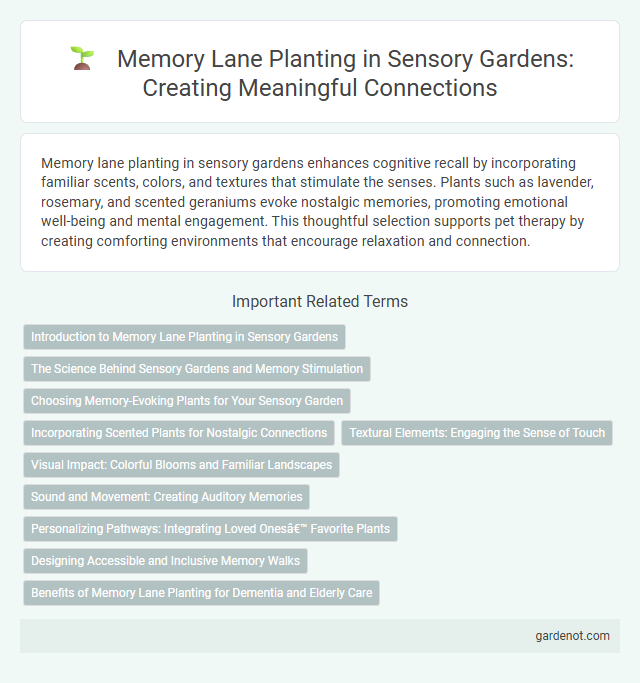Memory lane planting in sensory gardens enhances cognitive recall by incorporating familiar scents, colors, and textures that stimulate the senses. Plants such as lavender, rosemary, and scented geraniums evoke nostalgic memories, promoting emotional well-being and mental engagement. This thoughtful selection supports pet therapy by creating comforting environments that encourage relaxation and connection.
Introduction to Memory Lane Planting in Sensory Gardens
Memory Lane planting in sensory gardens incorporates plants that evoke nostalgia and stimulate memory through scent, texture, and color, enhancing cognitive engagement. This type of planting often features herbs like lavender and rosemary, known for their memory-triggering fragrances, alongside tactile plants such as lamb's ear to provide a multi-sensory experience. By designing pathways with these carefully selected species, Memory Lane planting supports cognitive health and emotional connection for visitors, especially those with memory impairments.
The Science Behind Sensory Gardens and Memory Stimulation
Memory lane planting in sensory gardens leverages multisensory stimuli--sight, smell, touch, and sound--to activate neural pathways associated with memory recall and cognitive function. Scientific studies in neuropsychology demonstrate that engaging multiple senses simultaneously enhances hippocampal activity, promoting synaptic plasticity and improving memory retention, particularly in individuals with dementia or Alzheimer's disease. Incorporating aromatic herbs, textured foliage, and vibrant colors in these gardens stimulates the brain's limbic system, crucial for emotional memory and sensory processing.
Choosing Memory-Evoking Plants for Your Sensory Garden
Select plants with strong sensory associations such as lavender, rosemary, and jasmine, known for their aromatic and calming properties that trigger vivid memories. Include textured foliage like lamb's ear and colorful blooms like marigolds to engage tactile and visual senses, enhancing recollection. Incorporate nostalgic species linked to personal or cultural history to deepen emotional connections within the sensory garden.
Incorporating Scented Plants for Nostalgic Connections
Memory lane planting in sensory gardens emphasizes incorporating scented plants such as lavender, rosemary, and jasmine, which evoke strong nostalgic connections through their familiar fragrances. These aromatic plants stimulate the olfactory senses, triggering memories and emotional responses linked to past experiences. Strategic placement along garden paths enhances engagement and creates a multi-sensory environment that supports memory recall and cognitive health.
Textural Elements: Engaging the Sense of Touch
Memory lane planting in a sensory garden emphasizes textural elements such as soft lamb's ear, coarse ornamental grasses, and rough bark surfaces to engage the sense of touch. Varied leaf textures--from the smoothness of hostas to the fuzziness of sage--create tactile contrast that stimulates memory recall and sensory exploration. Incorporating plants with distinct tactile qualities enhances cognitive connection and emotional engagement for visitors, especially those with memory impairments.
Visual Impact: Colorful Blooms and Familiar Landscapes
Memory lane planting in sensory gardens enhances visual impact through vibrant, colorful blooms that evoke nostalgia and comfort. Incorporating familiar landscapes with seasonal flowers like lavender, marigolds, and roses stimulates memory recall and emotional connection. Strategic color contrasts and layered plantings create immersive pathways that engage sight and promote cognitive well-being.
Sound and Movement: Creating Auditory Memories
Memory lane planting in sensory gardens incorporates plants like ornamental grasses and bamboo to produce soothing rustling sounds, enhancing auditory experiences. Incorporating wind chimes and seed pods adds dynamic movement, engaging visitors with gentle natural sounds and visual rhythms. This combination fosters strong auditory memories by stimulating both sound and movement senses simultaneously.
Personalizing Pathways: Integrating Loved Ones’ Favorite Plants
Memory lane planting enhances sensory gardens by personalizing pathways with loved ones' favorite plants, fostering emotional connections and nostalgia. Integrating species like fragrant lavender, vibrant marigolds, or soothing rosemary stimulates memories through scent and color. This tailored approach transforms garden walks into meaningful experiences that celebrate individual histories and strengthen bonds.
Designing Accessible and Inclusive Memory Walks
Memory lane planting in sensory gardens incorporates diverse textures, colors, and fragrances to stimulate cognitive engagement and evoke vivid memories for individuals with dementia or memory loss. Designing accessible and inclusive memory walks involves smooth, wide pathways with tactile elements at varying heights to accommodate wheelchairs and strollers, ensuring ease of navigation for users of all mobility levels. Integrating familiar plants such as lavender, rosemary, and rosemary alongside interactive features enriches sensory experiences while promoting emotional connection and mental well-being.
Benefits of Memory Lane Planting for Dementia and Elderly Care
Memory Lane Planting enhances cognitive function by engaging multiple senses through familiar and fragrant plants, which can trigger positive memories and emotional responses in individuals with dementia. This therapeutic gardening approach promotes mental stimulation, reduces anxiety, and improves mood for elderly care residents by creating a calming, interactive environment. Incorporating native herbs, colorful flowers, and textured foliage supports sensory engagement, encouraging social interaction and physical activity.
Memory lane planting Infographic

 gardenot.com
gardenot.com